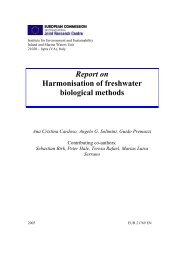Lakes and Watercourses
Lakes and Watercourses
Lakes and Watercourses
You also want an ePaper? Increase the reach of your titles
YUMPU automatically turns print PDFs into web optimized ePapers that Google loves.
Class 1 in the overall index indicates that the fish fauna of the watercourse<br />
consists of a large number of species with high diversity, many<br />
fishes with a high proportion of salmonids having a high reproduction<br />
level. A classification around class 3 indicates a watercourse close to the<br />
median for Swedish watercourses. Class 5 indicates an ecosystem poor in<br />
species <strong>and</strong> individuals <strong>and</strong> with an absence of salmonids.<br />
Assessment of deviation from reference values<br />
Note that deviation from reference values for lakes (Table 46) is not<br />
calculated for the parameters ”Presence of species <strong>and</strong> stages sensitive to<br />
acidification”, ”Proportion of tolerant fish species” <strong>and</strong> ”Proportion of<br />
alien species”, the deviation can instead be obtained directly by comparing<br />
the recorded value with the classes in table 46. In these cases the<br />
value for class 1 is the result obtained in waters with no or insignificant<br />
impact.<br />
Class boundaries have been adjusted to existing parameters <strong>and</strong> background<br />
data. With a few isolated exceptions, the 50th, 25th, 10th <strong>and</strong> 5th<br />
percentiles have been used for one-sided parameters, which means that<br />
50 per cent of the background data will fall within class 1. The 2nd, 5th,<br />
10th <strong>and</strong> 25th percentiles <strong>and</strong> the 75th, 90th, 95th <strong>and</strong> 98th percentiles,<br />
respectively, have been used for double-sided parameters. Here, too, 50<br />
per cent of the background data falls within class 1.<br />
Note that reference values for watercourses are only calculated for the<br />
”Number of species” parameter. The parameters ”Weight/100 m 2 ” to<br />
”Proportion of alien fish species” are calculated as described in the<br />
footnote. In these cases the value for class 1 is the result obtained in<br />
waters with no or insignificant impact.<br />
Comments<br />
The assessments must be based on fish surveys carried out in accordance<br />
with the instructions given in the Swedish EPA Environmental Monitoring<br />
H<strong>and</strong>book. Hence, lakes having a surface area of less than 10 ha<br />
should not be included. Assessment of current conditions <strong>and</strong> deviations<br />
should also be made with a degree of insight. This is particularly so<br />
where the absence of species <strong>and</strong> stages forms part of the assessment (eg,<br />
proportion of species sensitive to acidification <strong>and</strong> proportion of alien<br />
species). In exceptional cases, natural variations may lead to erroneous<br />
interpretations. Assessment of lakes over 500 m above sea level should be<br />
made with great caution owing to the absence of data on high altitude<br />
lakes <strong>and</strong> lakes with predominantly salmonid assemblages. The background<br />
data on watercourses in lowl<strong>and</strong> areas is similarly limited. Help<br />
with calculations may be obtained from the data host for fish (Institute of<br />
Freshwater Research, National Board of Fisheries).<br />
75















![Accommodation booking form [PDF]](https://img.yumpu.com/39471785/1/184x260/accommodation-booking-form-pdf.jpg?quality=85)

